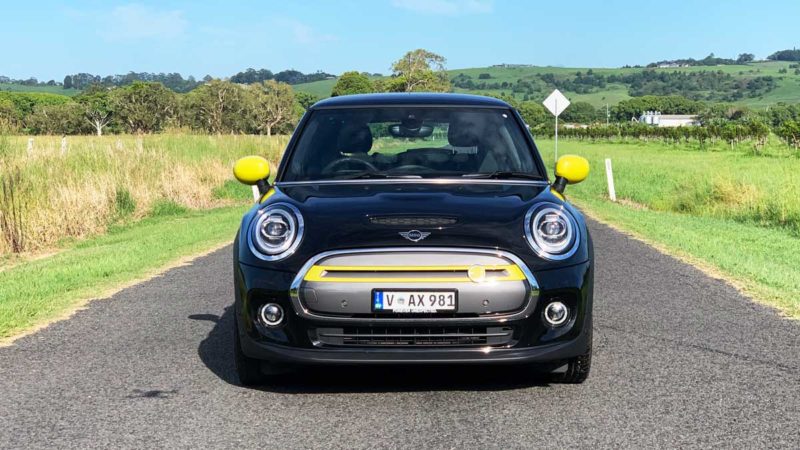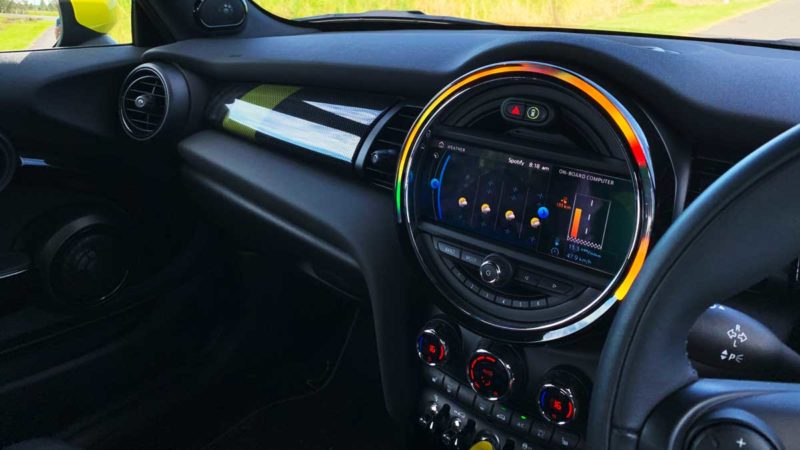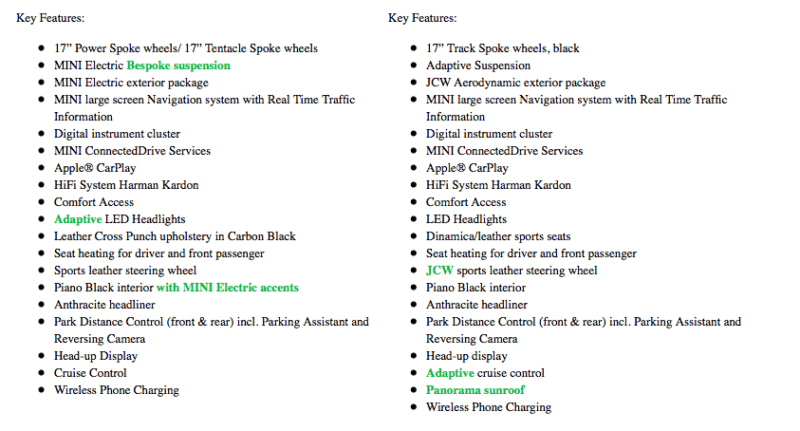It’s reasonably well established that the town of Mullumbimby, just outside of Byron Bay in the Northern Rivers region of NSW, is considered to be the “anti-vax” capital of Australia. And thanks partly to the urgings of a newly arrived former TV cooking show judge, some of the residents also hold deep suspicions over new technologies.
As an example, “wi-fi death-boxes” is one description I’ve heard on several occasions of my electric vehicle (a Tesla Model 3) by some residents of Mullumbimby, my closest town. So when an electric Mini with a number plate VAX was delivered recently for a test drive, all I could do was to console myself that it didn’t have 5G on the number plate too.
And it is not as though BMW has designed the electric Mini to go incognito. Like the I3 that preceded it, BMW seems to want its early electric models to stand out in a crowd, and in the case of the Mini they come in a blaze of different colours and trimmings.
This Mini was all black with big splashes of yellow. As a fan of the reigning AFL premiers, the Richmond Tigers (team colours black and yellow), I didn’t mind a bit, although when my mother-in-law compared the bright yellow rear view mirrors to Tony Abbott’s ears, that created an image that stuck in my mind for pretty much the whole week of the EV loan. I even checked for budgie smugglers in the boot.
The Mini has fascinated me since the first time I travelled in one decades ago in the UK, in a vehicle owned by a friend measuring at least 192cm. How does a car that looks so small on the outside accommodate at least two fully grown people on the inside?

The modern Mini has bulked up from the 1970s version, and now that it is owned by BMW it has the stamp of European quality too. And the interior feels less like a Doctor Who Tardis and more like a modern juke box – such is the assault on the senses from the bright lights and multiple screens that make up its control systems.
On the outside, the modern Mini has smooth lines. On the inside, it’s rectangular and feels a little bit boxy. Maybe that’s why the designers thought: “Let’s decorate it!” And they did, splashes of colour, in this case yellow, a big round screen, and a series of toggle switches typical of a Mini that would not look out of place in a plane cockpit.
There are two main difficulties with EV uptake in Australia. One is price and the other is range. Let’s tackle the range issue first.
In Sydney, a few months earlier, BMW didn’t help with the range anxiety issue by giving me the keys to a loan car with less than 50 per cent charge, and vague instructions of how and where to charge it.
“Try Tesla, or a shopping centre. You can Google it!” I was told by one of the staffers at the dealership. But that’s not true about Tesla charging stations, and if you can find a charging station in a shopping centre, it is likely to need an adaptor or cable, and I wasn’t provided with either.
I wrestled with one outlet at the Harbord Diggers in Freshwater before giving up (the Tesla chargers were not compatible, of course, and the other charging points needed to be activated by an app, but there was no mobile phone reception in the parking lot where the charger is located).
I scuttled off to my digs in Sydney to plug the Mini into the power point in the garage and trickle charge it overnight, and cancelled plans to drive it to a dinner date on the other side of town. And it made me wonder what a punter not used to EVs might have thought of the experience.
This is not an issue unique to Mini and BMW. It’s common across many car companies to have headquarters enthusiastically promote the new EV models, while the memo, and/or the motivation, has not yet got through to the dealers.
Mini headquarters was clearly embarrassed, and shipped a car up as soon as they could up to The Driven’s headquarters. You can read Bridie Schmidt’s enthusiastic account of her time with the Mini here.
So, after all that, what is it like to drive?
Pretty cool actually. Like any EV, the electric Mini is quick off the mark, has sure handling, and in towns and the city, with the constant stop start driving and sitting in traffic, it is blissfully quiet – even if it has a low electronic whirr that can be heard at low speeds.
The Mini has three settings of regenerative braking – the big new difference for anyone new to EVs. I do like regenerative braking and always choose the highest, because it enables one foot driving (where you rarely need to touch the brakes), and it puts more back into the battery.
It has several driving settings too. Eco and Eco plus, normal and Sport. Given that a Mini EV owner has already paid a premium to drive a zero emissions car with no tailpipe emissions – the nasty particulates that contribute to the death of nearly 2,000 people a year in Australia, and millions around the world – I figure that a Mini driver has done enough “green” and is entitled to go sport mode.

It’s worth it. There is that much more zip on sport mode, and that much more acceleration. The Mini can take off at the lights, but the steering does feel looser in those periods of super rapid acceleration than, say, a Tesla. But the idea is that you drive to your abilities, and the road rules.
This car may not have broad appeal, but there is a definite target market. My daughter hopped in and had a quick drive, and my son and his wife took it for a day. Their response? “I like it” and “Can I/we have one”. They said the car was definitely cool, and a nice way to get around town.
It’s just that there’s no room for more than one friend or partner, and only really small kids or a small dog in the back seat. You could describe it as a family favourite without actually being a family car.
You could take it on a road trip, but you’d need careful planning and right now that’s harder than it should be because Australia just doesn’t have the charging infrastructure. So it’s more likely to be a city car, or in an area like the northern Rivers where the distances are not too great, but there is plenty of charging infrastructure around.
But the winningest part of the electric Mini is its price, which is actually barely different from the fossil fuel version. And that makes it a no-brainer.
This table below shows that the Mini, clean or dirty, electric or fossil fuel, is not exactly cheap.

But it does have pretty much the same features. You can see more detailed comparisons in the table below. As our BMW contact noted: “You’ll see that both models bring plenty to the table at this price point, and that the MINI Electric is really not asking a large premium over this version of the Cooper S at just $900 dearer.”
In the table below he’s higlighted in green what makes each version better than the other. It’s an even contest.
That is really significant, because it means that price parity for electric cars has already arrived in Australia, at least for this model. And it begs the question, if you are in the market for a Mini, with all the whizz-bang additions, why wouldn’t you want to get the Mini Electric?


Giles Parkinson is founder and editor of The Driven, and also edits and founded the Renew Economy and One Step Off The Grid web sites. He has been a journalist for nearly 40 years, is a former business and deputy editor of the Australian Financial Review, and owns a Tesla Model 3.

